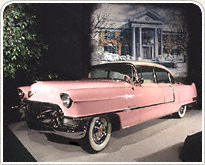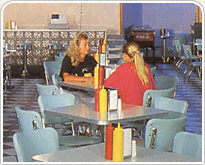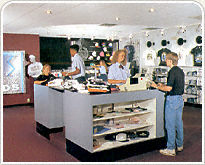political
economy
Purchased by Elvis Presley for $100,000
in 1957, Graceland, a faux Georgian revival manor located in the suburban
sprawl of Memphis, Tennessee, was estimated to be worth in excess of $100
million in 1993 (1). Visitors to the home that Elvis resided at for the
last 20 years of his life can choose from five different tours of the
estate: The mansion tour, the automobile museum, the airplane tour, “Sincerely
Elvis”—a tour featuring Elvis’ personal effects, and
the all-inclusive “Platinum Tour.” The complex has museums,
a restaurant, a small movie theater, several concessions, and of course,
a gift shop. An idea first conceived by Elvis Presley’s ex-wife
Priscilla Presley and her lawyer Jack Soden, Graceland has helped resurrect
Elvis’ image as well as launch an astonishingly successful business,
Elvis Presley Enterprises. Highly successful from its inception, Graceland
was opened following a $500,000 investment by Ms. Presley in 1982. This
investment was returned in 38 days.
Beginning at his arrival at Graceland,
Elvis showed great pride for his home city of Memphis. Decorating his
mansion, he insisted on everything Memphis-made of Memphis-bought: Crystal
chandeliers, gilded mirrors, stained glass, porcelain nudes, heavy draperies
to block out sunlight. However, regardless of Elvis’ previous contributions
to and pride for Memphis, as well as Graceland’s present success,
any contribution is more than what was expected of Elvis’ home by
Memphis at the time of Elvis’ death. Burdened by the cost of keeping
Graceland, Elvis’ executors tried to sell it to the city of Memphis
for only $3 million—only two thirds of its estimated 1977 worth.
The city refused the offer, thinking that interest in Elvis would soon
fade (2). By 1992, however, upwards of 700,000 visitors per year were
visiting Memphis to see the home and burial place.
Despite drawing hundreds of thousands of visitors each year to Memphis, a city that has undergone massive urban renewal projects to improve its decaying infrastructure, Graceland does not contribute all it can to the city’s economy. The aforementioned restaurant and concessions, like those of all themed spaces, detract from the potential profits of local businesses. And due to its location in the suburban sprawl of Memphis, it does not do much to help the situation downtown. The type ofcontribution Graceland does make to Memphis can be seen on Elvis Presley Boulevard—the road that Graceland’s tours depart from. The boulevard is a four lane suburban highway dominated by fast food franchises and car dealerships (1)—a contribution hardly worthwhile to the city as a whole.
Although the increase in commerce of the surrounding sprawl can be seen
as better than nothing to Memphis, Graceland’s popularity is poorly
utilized. Like the restaurants and concessions located on the main estate,
the Elvis Presley Enterprises owned Elvis Presley’s Heartbreak Hotel,
featuring the Hollywood Suite, the Gold & Platinum Suite, and the
Burning Love Suite, also draws potential business away from the surrounding
area. However, this is not too much of a loss considering the other hotels
that this business draws customers from—Days Inn at Graceland, Comfort
Inn Airport-Graceland, and Ramada Inn Airport-Graceland—all owned
by corporations that are have little to no inherent interest in the fate
of the city of Memphis.



When urban cores became popular destinations for
shopping in themed spaces in the 1990s, Memphis capitalized on Graceland’s
existence and the mark that Elvis left on the city as much as it could.
Beale Street, a district that was predominantly African American and the
center of Memphis’ music community in the 1950s, and was considered
a combat zone during the tumultuous sixties and seventies, has been “urban
renewed and urban removed”(4) and restored to represent a sterilized
version of Beale Street during its heyday for predominantly white tourists.
Located on Beale Street are a Hard Rock Café, B.B. King’s
Blues Club, the Blues City Café, and various other blues and rock
and roll related businesses. The development of Beale Street by the Memphis
growth machine was undoubtedly helped substantially by the legacy of Elvis,
whose first music was recorded at Beale Street’s Sun Studios—a
location that has been transformed into a themed space all its own (3).
Also located on Beale Street is “Elvis Presley’s Memphis,”
a restaurant and nightclub. The restaurant serves meals made from Elvis’
mother’s recipes and includes many of his favorite dishes on the
menu. The 300-seat facility uses state-of-the-art sound, lighting, and
video to highlight the musical performances live on stage as well as special
videos produced especially for the club (5). These locations, which are
undoubtedly frequented by visitors to Graceland seeking entertainment
outside of the King’s 23-room mansion, play pivotal roles in ensuring
the success of Beale Street.
According to the Memphis Convention and Visitors
Bureau, 4.2 million visitors came to Beale Street last year, making it
the number one tourist attraction in this community. In fact, Beale Street
was ranked ahead of all tourist attractions in West Tennessee, including
Graceland.
Despite the fact that Elvis died a quarter of a century ago, his home
and burial place continue to draw hundreds of thousands of tourists to
Memphis each year. Although Graceland is located in the sterile suburban
sprawl outside of the central city, its presence as of late has contributed
greatly to the development of inner city entertainment districts.
1. Reed, J.D. “The mansion music made; there’s
still good rockin’ at Elvis Presley’s Graceland.” Time
Magazine, 19 December 1998, p 10.
2. “Sellvis.” The Economist, 10 April 1993, p 66.
3. Stetson, Fred. “Going to Graceland.” Montreal Gazette,
3 August 2002, p I1.
4. Worley, Bill. “Beale Street—a multicultural tourist destination
with a twist.” Lies Magazine, http://www.cent.com/abetting/L14Beale.html
“Elvis in Memphis” Elvis Presley Enterprises, 2002. http://www.elvis.com/epmemphis.
